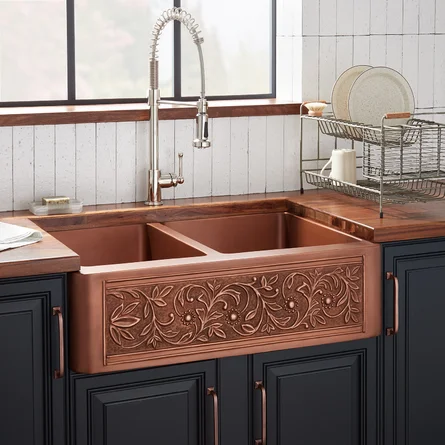
The sink is easily one of the hardest working features in your entire kitchen. They’re masters of hybridized functionality and style and need to both reflect the identity of your space while simultaneously perform flawlessly under rigorous conditions.
Kitchen sinks have come a long way since being bowls of water perched under a hand pump. Today, they can be elaborate, simple, linear, expensive, thrifty, and can feature a wealth of accessories like cutting boards, utensil trays, garbage disposals, and drying racks for dishes.
The kitchen sink is much more than a spot to wash a few dishes, so in this post, we’re illustrating and discussing some of the most coveted and stylish kitchen sink features, materials, styles, and designs.
Bigger is Better
Long gone are the days of compartmentalized, tiny double sinks. These days, you’d be hard pressed to find a dream kitchen with a small, double sink, on account of the fact they can’t accommodate the bulky, large pots and pans a gourmet designer kitchen calls for these days.
Most discerning homeowners are embracing the concept of oversized, deeper sinks that are as much for show as they are functional. In most cases, a large primary sink will be offset by a smaller prep sink (we’ll expand on that later).
Materials
Think stainless steel is all the choice you have when it comes to a sink? You’d be mistaken. In today’s market, there are a plethora of modern and innovative materials that can be used to manufacture a stunning sink setup that’s perfectly suited to your dream kitchen plans. From wood and concrete to quartz and porcelain, sinks are as varied as any other prime kitchen feature these days.

Stainless Steel
One of the oldest and most conventional materials for a sink is undoubtedly stainless steel. Stainless is relatively inexpensive, reliable, and durable, making it a prime choice for classic kitchen aesthetics and a budget that’s promised a lot to other corners of the space.
Stainless steel can be manipulated to any number of shapes, allowing the standard look in your mind’s eye to be revamped and reimagined in new, crisp, and lavishly geometric forms. The finish of stainless can be customized as well – opt for a brushed look, or an aluminum style finish to help elevate the material into a new realm of style.
Copper
Copper is a native metal, meaning it’s one of the few metals found in nature that’s readily useable in its found metallic form – eventually leading it to be the first metal ever smelted, cast into the shape of a mold, and combined with another metal (tin) to create an alloy (bronze).
Copper sinks offer a unique stamp on your kitchen space that enhances the warmth and of the room by offering a deep amber-hued foal point that beautifully contrasts bright rooms. Copper sinks can be cast from a mold, or hand-shaped and hammered in some cases to add an artisanal element to your kitchen. And no, they won’t turn green. As a living metal, copper holds the capacity to protect itself and will develop a rich patina over time, intensifying its colour and beauty.
Enameled Cast Iron
Often associated with apron-style or farmhouse sinks, enameled cast iron is a distinctive sink material cast of durable iron alloy and cast in a porcelain enamel coating at extremely high temperatures, giving it a shiny, smooth, and glossy surface.
Iron enamel sinks won’t crack or dent thanks to the epic durability of cast iron, making them a great choice for a forever home’s dream kitchen, although they weigh a boatload, meaning undermount cast iron enamel sinks require ample bracing underneath the cabinetry to support the weight of the piece.
Bamboo
This one is wild – it’s not every day you’d imagine a wooden sink as something that’s in the realm of possibilities for your dream kitchen but bamboo sinks are becoming a sought-after feature of many modern and eclectic homes for their exoticism, their warmth, and their unique aesthetic that separate them from the rest of the space.
Bamboo is harder than red oak and maple and has higher tensile strength and compression strength than even steel. Bamboo sinks are typically constructed using layered strips of bamboo, and laminated with binding adhesives and a water-resistant topcoat to help keep the water where you want it and extend the life of the wood itself.
Integrated Stones
Integrated stone sinks make for seamless designs that are ultra-slick and transitionless, allowing for easy cleanup and a high-end modern aesthetic that’s wildly desirable in today’s dream kitchens. Quartz is a composite stone, man-made with a combination of approximately 70% crushed quartz and acrylic resin. Granite composites sinks are another popular choice with a more natural looking finish.
Offered as an option by many countertop manufacturers, integrated composite stones like quartz or natural marble sinks are very durable, reliable, and unlikely to scratch or crack over time.
Concrete
Concrete sinks are developing a strong identity as versatile alternatives to stone and metal options – and on top of that, they’re stunning. Concrete possesses natural imperfections and variations in colour that helps to extend its beauty as a utilitarian sink material, and they’re entirely customizable.
Concrete sinks can be shaped in nearly any shape, in any size, and in any style – but be prepared to treat your concrete sink to protect against staining, discoloration, nicks, and scratches over time – it’ll never be as hard as granite or quartz, as it’s a porous material – so do your research when considering this beautiful option.
Self-Rimming/Drop-in
Also referred to as drop-in sinks, self-rimming sinks are available in nearly every type of material and remain the most popular for their ease of installation, price point, and versatility. They’re easy to clean and exceptionally easy to maintain and install – the rim (typically stainless steel) supports the weight and structure of the sink itself above the countertop surface.
Undermount Sinks
Installed below the countertop to help develop a more seamless and elite aesthetic, undermount sinks are growing in popularity thanks to their utilitarian functionality and easy cleanup routine. Undermount sinks can only be used in conjunction with a solid surface countertop like granite, marble, or a composite stone like quarts, as the edges of the sink cut-out would be exposed, making the undermount approach a desirable and noticeable add-on for a dream kitchen space.
Apron Sinks
Perhaps one of the most sought-after and coveted kitchen styles is that of the apron, or farmhouse style sink that’s become a staple of spaces seeking authenticity, livability, and charm. Apron sinks are typically deeper, wider, and heavier than your standard sink choice and are perfect solutions for a busy household with children, or in a gourmet kitchen that sees a wealth of specialized, oversized equipment used.
They’re typified by the large front apron or exposed front that is quintessential to drawing attention to the sink and adds a zest of homey style. Look for most apron sinks to be made from enameled cast iron, but modern iterations in stainless steel, copper, and marble are not uncommon.
Prep Sinks
In 2018, we saw more and more homeowners seeking to take the load off their main kitchen sink by supplementing a prep sink, or a bar sink elsewhere in the kitchen – like the island, or near the wet bar. The growing trend of a prep sink can help to reduce the overall square footage of the coveted kitchen triangle layout for kitchen functionality and is a great way to add versatility to your kitchen routine.
They’re not just great in the kitchen either, consider adding a small prep or bar sink in the family room where the bar is located for quick ice-making, or as a wash station for glassware.
Sinks are a staple of the kitchen triangle model – pull one of the three pillars out from under itself, and the kitchen fails. Alongside the stove and prep space, the sink is a non-negotiable aspect of a true dream kitchen; have you put in the time and effort to research what type of sink is going to make its way into your new space?